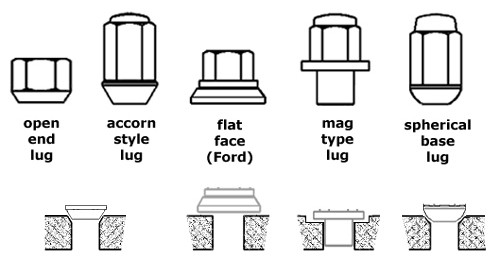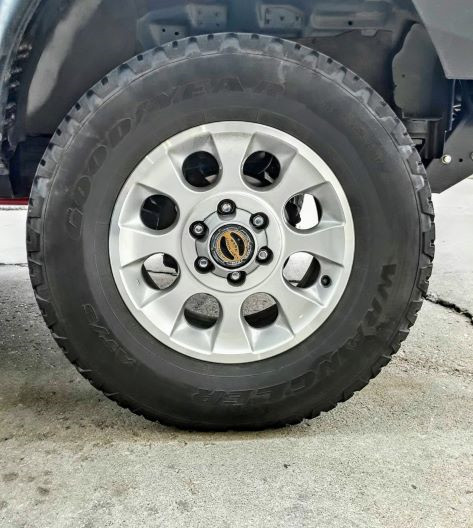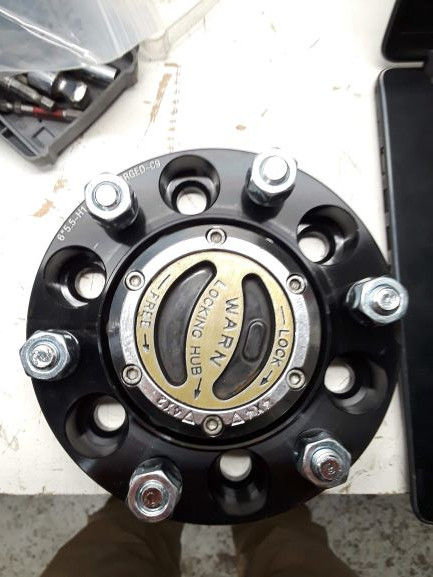Are All Toyota 6 Lug Wheels The Same? No, all Toyota 6-lug wheels are not the same, and understanding the nuances is crucial for safe and proper fitment, which is why at millertoyota.net, we provide detailed specifications and expert advice to ensure you get the perfect match for your Toyota, offering peace of mind and optimal performance, whether you’re looking for replacements or upgrades. Let’s explore the factors determining compatibility and how Miller Toyota can help you find the right wheels. From lug patterns to hub bore sizes and beyond, we’ll cover everything you need to know about Toyota wheel fitment, ensuring you make informed decisions for your vehicle with wheel and tire services, automotive customization, and vehicle maintenance.
1. Understanding Toyota 6-Lug Wheels
Toyota 6-lug wheels are a common sight on many of their trucks and SUVs, known for their robust design and functionality. However, the term “6-lug” only refers to the number of bolts used to secure the wheel to the vehicle’s hub. While this is a primary similarity, numerous other factors differentiate these wheels, impacting their interchangeability.
1.1. What Does 6-Lug Mean?
The term “6-lug” refers to the bolt pattern of the wheel, indicating that it uses six lug nuts to secure the wheel to the vehicle’s hub. This configuration is typically found on trucks and SUVs due to its ability to handle higher loads and provide better stability.
1.2. Why 6-Lug Patterns Are Common on Trucks and SUVs
Six-lug patterns are common on trucks and SUVs because they offer increased strength and load-bearing capacity compared to 5-lug or 4-lug patterns. The additional lug nut helps distribute the vehicle’s weight more evenly, reducing stress on the wheel and hub assembly.
1.3. Common Toyota Models That Use 6-Lug Wheels
Toyota uses 6-lug wheels on a variety of models, including:
- Tacoma
- Tundra
- 4Runner
- FJ Cruiser
- Land Cruiser
- Sequoia
These vehicles benefit from the robust design and load-bearing capabilities of 6-lug wheels, making them suitable for both on-road and off-road applications.
2. Key Factors That Determine Wheel Compatibility
Several factors determine whether a wheel is compatible with a specific vehicle. Ignoring these factors can lead to improper fitment, compromising safety and performance.
2.1. Bolt Pattern (PCD)
The bolt pattern, also known as Pitch Circle Diameter (PCD), is the diameter of the circle formed by the centers of the wheel’s lug holes. It’s crucial that the bolt pattern of the wheel matches the vehicle’s hub for proper fitment.
2.1.1. How to Measure Bolt Pattern
To measure the bolt pattern on a 6-lug wheel, measure the distance between the centers of two lug holes directly across from each other. This measurement will typically be in millimeters (mm) or inches.
2.1.2. Common Toyota 6-Lug Bolt Patterns
The most common 6-lug bolt pattern for Toyota vehicles is 6×5.5 inches (6×139.7 mm). This pattern is used on many of their trucks and SUVs, including the Tacoma, 4Runner, and FJ Cruiser.
2.2. Center Bore (Hub Bore)
The center bore is the diameter of the hole in the center of the wheel that fits over the vehicle’s hub. This is a critical factor for ensuring the wheel is properly centered on the hub.
2.2.1. Importance of Proper Center Bore Fitment
A proper center bore fitment ensures that the wheel is centered on the hub, reducing vibrations and stress on the lug nuts. If the center bore is too small, the wheel will not fit. If it’s too large, the wheel may not be properly centered, leading to potential issues.
2.2.2. Common Center Bore Sizes for Toyota 6-Lug Wheels
The center bore size for Toyota 6-lug wheels is typically around 106 mm. However, this can vary depending on the model and year of the vehicle.
2.3. Wheel Offset
Wheel offset is the distance between the wheel’s mounting surface and its centerline. It affects how the wheel sits in the wheel well and can impact steering and suspension geometry.
2.3.1. Understanding Positive, Negative, and Zero Offset
- Positive Offset: The wheel’s mounting surface is closer to the outside of the wheel. This tucks the wheel further into the wheel well.
- Negative Offset: The wheel’s mounting surface is closer to the inside of the wheel. This pushes the wheel further out from the wheel well.
- Zero Offset: The wheel’s mounting surface is in line with the centerline of the wheel.
2.3.2. How Offset Affects Vehicle Handling and Appearance
Offset affects the vehicle’s handling by changing the scrub radius, which is the distance between the steering axis and the center of the tire’s contact patch. Incorrect offset can lead to increased steering effort, uneven tire wear, and altered handling characteristics. It also affects the vehicle’s appearance, with negative offset providing a wider, more aggressive stance.
2.4. Wheel Diameter and Width
Wheel diameter and width are straightforward measurements, but they must be compatible with the vehicle’s specifications to avoid rubbing or clearance issues.
2.4.1. Recommended Wheel Sizes for Different Toyota Models
- Toyota Tacoma: 16-18 inches diameter, 7-8.5 inches width
- Toyota 4Runner: 17-20 inches diameter, 7.5-9 inches width
- Toyota Tundra: 18-22 inches diameter, 8-10 inches width
2.4.2. How to Ensure Proper Clearance and Avoid Rubbing
To ensure proper clearance and avoid rubbing, check the vehicle’s owner’s manual or consult with a professional at millertoyota.net. Ensure the wheel and tire combination fits within the wheel well without interfering with suspension components or the vehicle’s body.
2.5. Lug Nut Type and Seat Angle
The lug nut type and seat angle must match the wheel’s lug nut seat for proper and safe fastening.
2.5.1. Conical, Ball, and Flat Seat Lug Nuts Explained
- Conical (Acorn) Seat: Features a cone-shaped seat that centers the wheel on the hub.
- Ball (Radius) Seat: Features a rounded seat that matches the curvature of the wheel’s lug holes.
- Flat Seat: Features a flat seat with a shoulder that presses against the wheel’s mounting surface.
2.5.2. Importance of Using the Correct Lug Nuts
Using the correct lug nuts ensures that the wheel is properly secured to the hub, preventing loosening and potential wheel failure. Always use the lug nuts specified for the wheel and vehicle combination.
 Toyota Wheel Hub
Toyota Wheel Hub
3. Variations in Toyota 6-Lug Wheels
While many Toyota models share the 6-lug pattern, variations exist between different models and model years.
3.1. Differences Between Tacoma, 4Runner, and Tundra Wheels
- Tacoma: Typically has smaller wheel sizes and narrower widths compared to the Tundra. The offset is also different.
- 4Runner: Similar to the Tacoma in terms of wheel size, but may have different styling and offset options.
- Tundra: Features larger wheel sizes and wider widths to accommodate its larger size and higher load capacity.
3.2. Model Year Specific Variations
Toyota may change wheel designs and specifications from year to year. Always verify the wheel’s compatibility with the specific model year of your vehicle.
3.3. Aftermarket vs. OEM Wheels
- OEM Wheels: Original Equipment Manufacturer wheels are designed and manufactured by Toyota for specific models. They ensure a perfect fit and maintain the vehicle’s original specifications.
- Aftermarket Wheels: Manufactured by third-party companies, aftermarket wheels offer a wider range of styles, finishes, and sizes. However, it’s crucial to ensure they meet the vehicle’s specifications for safe and proper fitment.
4. How to Determine If a Wheel Fits Your Toyota
Determining whether a wheel fits your Toyota involves checking several key specifications and measurements.
4.1. Checking Your Vehicle’s Specifications
Consult your vehicle’s owner’s manual or the sticker on the driver’s side doorjamb for the recommended wheel and tire specifications.
4.2. Using Online Fitment Guides
Many online fitment guides can help you determine which wheels are compatible with your vehicle. Enter your vehicle’s year, make, and model to find a list of suitable options.
4.3. Consulting with a Professional
Consulting with a professional at millertoyota.net is the best way to ensure proper wheel fitment. Our experts can help you navigate the complexities of wheel specifications and ensure you choose the right wheels for your vehicle.
4.4. Test Fitting Wheels
If possible, test fitting wheels before purchasing them is a good idea. This allows you to visually inspect the fitment and ensure there are no clearance issues.
5. Common Problems and Solutions
Improper wheel fitment can lead to various problems, including rubbing, vibration, and even wheel failure.
5.1. Wheel Rubbing Issues
Wheel rubbing occurs when the tire comes into contact with the vehicle’s body or suspension components.
5.1.1. Causes of Rubbing
- Incorrect wheel offset
- Oversized tires
- Suspension modifications
5.1.2. Solutions to Rubbing
- Use wheels with the correct offset
- Downsize tires
- Install a lift kit or leveling kit
5.2. Vibration Problems
Vibration can occur if the wheel is not properly centered on the hub or if the lug nuts are not tightened correctly.
5.2.1. Causes of Vibration
- Incorrect center bore
- Loose lug nuts
- Damaged wheels or tires
5.2.2. Solutions to Vibration
- Use hub-centric rings to center the wheel
- Torque lug nuts to the correct specification
- Inspect wheels and tires for damage
5.3. Lug Nut Issues
Using the wrong lug nuts or failing to tighten them correctly can lead to wheel loosening and potential failure.
5.3.1. Stripped or Broken Lug Nuts
Stripped or broken lug nuts can occur due to overtightening or using the wrong tools.
5.3.2. Solutions for Lug Nut Problems
- Replace damaged lug nuts
- Use a torque wrench to tighten lug nuts to the correct specification
- Ensure the lug nuts match the wheel’s lug nut seat
 Toyota Wheel Options
Toyota Wheel Options
6. Wheel Adapters and Spacers
Wheel adapters and spacers can be used to change the bolt pattern or offset of a wheel. However, they should be used with caution.
6.1. When to Use Adapters and Spacers
- Adapters: Used to change the bolt pattern, allowing you to install wheels with a different bolt pattern than your vehicle’s hub.
- Spacers: Used to increase the wheel offset, pushing the wheels further out from the vehicle.
6.2. Safety Considerations
Ensure that the adapters and spacers are of high quality and properly installed. Use the correct lug nuts and torque them to the specified value.
6.3. Potential Drawbacks
- Increased stress on wheel bearings and suspension components
- Potential for vibration if not properly installed
- May affect handling and stability
7. Maintaining Your Toyota Wheels
Proper maintenance can extend the life of your wheels and ensure they perform optimally.
7.1. Regular Cleaning
Clean your wheels regularly to remove dirt, brake dust, and road salt.
7.1.1. Recommended Cleaning Products
Use mild soap and water or a wheel-specific cleaner. Avoid using harsh chemicals or abrasive cleaners that can damage the wheel’s finish.
7.1.2. How to Properly Clean Wheels
- Rinse the wheels with water to remove loose dirt.
- Apply the cleaning solution and scrub with a soft brush or sponge.
- Rinse thoroughly with water.
- Dry with a clean microfiber towel.
7.2. Checking Tire Pressure
Maintain the correct tire pressure to ensure even tire wear and optimal handling.
7.2.1. Recommended Tire Pressure for Different Toyota Models
Refer to your vehicle’s owner’s manual or the sticker on the driver’s side doorjamb for the recommended tire pressure.
7.2.2. How Tire Pressure Affects Wheel and Tire Wear
- Underinflated Tires: Can cause uneven wear on the outer edges of the tire and increase the risk of tire failure.
- Overinflated Tires: Can cause uneven wear in the center of the tire and reduce traction.
7.3. Inspecting for Damage
Regularly inspect your wheels for signs of damage, such as cracks, bends, or corrosion.
7.3.1. Identifying Common Wheel Damage
- Cracks: Can occur due to impacts with potholes or curbs.
- Bends: Can cause vibration and uneven tire wear.
- Corrosion: Can weaken the wheel and affect its appearance.
7.3.2. When to Repair vs. Replace Wheels
Minor damage, such as scratches or light corrosion, can often be repaired. However, significant damage, such as cracks or bends, may require wheel replacement.
8. Customizing Your Toyota Wheels
Customizing your Toyota wheels can enhance its appearance and performance.
8.1. Painting or Powder Coating Wheels
Painting or powder coating your wheels can change their color and finish.
8.1.1. Benefits of Painting and Powder Coating
- Painting: Offers a wide range of color options and is relatively inexpensive.
- Powder Coating: Provides a durable, long-lasting finish that is resistant to chipping and scratching.
8.1.2. How to Properly Paint or Powder Coat Wheels
- Clean the wheels thoroughly.
- Sand the wheels to create a smooth surface.
- Apply primer.
- Apply paint or powder coat.
- Apply clear coat (if painting).
- Cure the finish according to the manufacturer’s instructions.
8.2. Adding Wheel Accessories
Wheel accessories, such as center caps and lug nut covers, can enhance the appearance of your wheels.
8.2.1. Types of Wheel Accessories
- Center Caps: Cover the center of the wheel, hiding the hub and bearings.
- Lug Nut Covers: Cover the lug nuts, providing a clean, finished look.
8.2.2. How to Choose the Right Accessories
Choose accessories that match the style and finish of your wheels. Ensure they are compatible with your vehicle’s specifications.
8.3. Upgrading to Larger or Wider Wheels
Upgrading to larger or wider wheels can improve your vehicle’s handling and appearance.
8.3.1. Performance Benefits of Larger Wheels
- Improved handling
- Increased stability
- Enhanced appearance
8.3.2. Considerations When Upgrading Wheel Size
- Ensure proper clearance
- Check for rubbing issues
- Maintain correct tire pressure
 Toyota Wheel Spacers
Toyota Wheel Spacers
9. Finding the Right Wheels at Miller Toyota
At millertoyota.net, we are committed to helping you find the perfect wheels for your Toyota.
9.1. Our Selection of Toyota Wheels
We offer a wide selection of OEM and aftermarket wheels to fit various Toyota models.
9.2. Expert Advice and Fitment Assistance
Our team of experts can provide advice and assistance to ensure you choose the right wheels for your vehicle.
9.3. Installation Services
We offer professional installation services to ensure your new wheels are properly installed and balanced.
9.4. Special Offers and Promotions
Check our website for special offers and promotions on wheels and tires.
10. Frequently Asked Questions (FAQs)
10.1. Will 5-Lug Wheels Fit on a 6-Lug Toyota?
No, 5-lug wheels will not fit on a 6-lug Toyota because the bolt patterns are different, requiring six lug nuts versus five. Attempting to force a fit could damage the vehicle and compromise safety.
10.2. Can I Use Aftermarket Wheels on My Toyota?
Yes, you can use aftermarket wheels on your Toyota, but ensure they match the vehicle’s specifications for bolt pattern, center bore, offset, diameter, and width for safety and performance. Always consult with a professional to confirm compatibility.
10.3. What is the Correct Way to Torque Lug Nuts?
The correct way to torque lug nuts is to use a torque wrench to tighten them in a star pattern to the manufacturer’s specified torque value, ensuring even pressure and secure wheel mounting. Refer to your vehicle’s owner’s manual for the correct torque specification.
10.4. How Often Should I Rotate My Tires?
You should rotate your tires every 5,000 to 7,000 miles to ensure even wear and extend their lifespan, contributing to better handling and safety. Consult your vehicle’s owner’s manual for specific recommendations.
10.5. Can I Mix and Match Wheel Sizes on My Toyota?
Mixing and matching wheel sizes on your Toyota is generally not recommended, as it can affect handling, stability, and the performance of safety systems like ABS and traction control. Always use the same size wheels on all axles unless specifically recommended by the manufacturer.
10.6. What Are Hub-Centric Rings and Do I Need Them?
Hub-centric rings are used to fill the gap between the wheel’s center bore and the vehicle’s hub, ensuring the wheel is centered correctly, reducing vibration, and improving overall wheel balance. They are needed when the wheel’s center bore is larger than the vehicle’s hub diameter.
10.7. How Do I Know If My Wheels Are Balanced?
You can tell if your wheels are balanced if you experience vibration in the steering wheel or seat while driving, indicating an imbalance in the wheel and tire assembly. Visit millertoyota.net for professional wheel balancing services.
10.8. What Should I Do If My Wheel Is Bent?
If your wheel is bent, you should have it inspected by a professional at millertoyota.net to determine if it can be safely repaired or if it needs to be replaced. Driving with a bent wheel can be dangerous and cause further damage to your vehicle.
10.9. Are Aluminum Wheels Better Than Steel Wheels?
Aluminum wheels are generally lighter than steel wheels, offering better fuel efficiency and handling, while steel wheels are more durable and cost-effective, making them suitable for heavy-duty applications. The best choice depends on your specific needs and driving conditions.
10.10. Where Can I Find Reliable Information About Toyota Wheel Specifications?
You can find reliable information about Toyota wheel specifications in your vehicle’s owner’s manual, on the sticker on the driver’s side doorjamb, or by consulting with a professional at millertoyota.net. Our experts can provide accurate and up-to-date information to help you make informed decisions.
Ensuring the proper fitment of wheels on your Toyota is crucial for safety, performance, and overall vehicle longevity. While many Toyota models share the 6-lug pattern, variations in bolt pattern, center bore, offset, and other factors mean that not all 6-lug wheels are the same. At millertoyota.net, we provide the expertise and resources you need to find the perfect wheels for your Toyota.
Ready to find the perfect wheels for your Toyota? Visit millertoyota.net today to explore our extensive selection, get expert advice, and schedule a professional installation. Drive with confidence knowing your wheels are properly fitted and optimized for performance! You can find us at 208 N Maple Grove Rd, Boise, ID 83704, United States or call us at +1 (208) 376-8888.